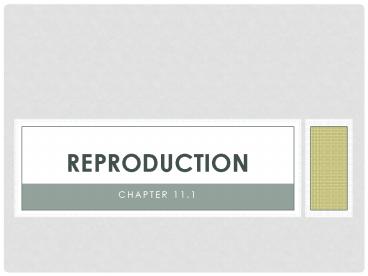Reproduction - PowerPoint PPT Presentation
1 / 40
Title:
Reproduction
Description:
REPRODUCTION CHAPTER 11.1 HAPLOID VS. DIPLOID CELLS Diploid cell- A cell that has two copies of each chromosome. This would include all somatic/body cells New cell ... – PowerPoint PPT presentation
Number of Views:76
Avg rating:3.0/5.0
Title: Reproduction
1
Reproduction
- Chapter 11.1
2
Recall the Two Important Questions we asked.
- What is the significance of Mitosis?
- Why do Chromosmes come in Pairs?
3
Asexual vs SexualReproduction
4
Characteristics ofASEXUAL REPRODUCTION
- One Parent
- Genetic Continuity Identical Offspring
- Many Offspring Quickly
- Less Maturation Time
- Nuclear Division MITOSIS
5
Types of Asexual Reproduction
6
Binary Fission (splitting in two)
7
(No Transcript)
8
(No Transcript)
9
(No Transcript)
10
Fragmentation - (pieces)
- Fragmentation- A kind of reproduction where the
body breaks into several pieces and the pieces
develop into complete adults.
11
Fragmentation - (pieces)
12
BUDDING
13
Budding
- New individuals split off of the original
organism.
14
CytoplasmDividesUnequally
bud
15
(No Transcript)
16
(No Transcript)
17
Multicellular Budding - sponge
18
Parthenogenesis
19
Parthenogenesis a process in which a female
produces an egg that develops into an adult
without ever being fertilized.
20
Cloning
21
(No Transcript)
22
(No Transcript)
23
More about cloning during Chapter 15!
24
Sexual Reproduction
- Requires two parents (cells)
- Union of special cells called GAMETES
- Sperm and Eggs or pollen and ovum
- Provides GENETIC VARIATION
- Usually mature more slowly
25
Types of Gametes
- Egg Sperm
- Pollen Ovum
26
Sexual Reproduction
- Advantages
- Genetic variation
- Genetically diverse populations are able to
withstand changes and disease better. - Disadvantages
- Need to expend energy looking for mate
- Produce fewer offspring.
27
Hermaphrodites
- Organisms with ovaries and testes
- Produce both eggs and sperm.
28
Earthworms have testes and ovaries
29
Chromosome review
- A chromosome is an X shaped object that contains
DNA. - Within the DNA lies the codes for every
characteristic of a living thing.
30
Chromosome review
- Every chromosome consists of two identical halves
called sister chromatids - The chromosome has a backup copy of the DNA.
31
Chromosomes
- Genes are located on located on chromosomes.
- Each chromosomes contains thousands of genes.
- A gene controls a specific trait such as your
height or hair color.
32
Chromosome numbers
- Every species has a specific number of
chromosomes. - Humans have 46 chromosomes or 23 pairs of
chromosomes.
33
Chromosome numbers
- Mosquitos have only 6 chromosomes in each cell.
- How many pairs of chromosomes does a mosquito
have?
34
Haploid vs. diploid cells
- Diploid cell- A cell that has two copies of each
chromosome. - This would include all somatic/body cells
- New cell will have an identical copy of DNA
- Diploid cells are produced by mitosis
- Mitosis is an asexual process.
- We call these cells 2N cells.
- Examples would include liver cells, etc.
35
Haploid vs. diploid cells
- Haploid cells- Have only one (half) set of
chromosomes. - This includes ONLY GAMETES (egg/sperm).
- The two gametes will combine to create a new
organism with full set of chromosomes (half from
mom, half from dad). - Haploid cells are created through meiosis.
- Meiosis is a sexual process.
- We call haploid cells 1N or N
36
Haploids vs. diploid cells
SPECIES HAPLOID (N) DIPLOID (2N)
HUMANS 23 ( chromosomes in sperm/egg) 46 ( chromosomes in somatic/body cells)
MONKEY 42
CORN 10
CATS 38
FRUIT FLY 4
37
HOMOLOGOUS CHROMOSOMES
- Homologous chromosomes- Each diploid cell has a
pair of chromosomes known as homologous
chromosomes. - They are similar in shape size and genetic
make-up. - In each homologous pair one chromosome came from
your mother and one from your father.
38
Homologous pairs
39
Autosomes vs. sex chromosomes
- Autosomes- Chromosomes with genes that do not
determine the sex of an individual. - Sex chromosomes- Chromosomes that do determine
the sex of an individual.
40
Autosomes vs. sex chromosomes
Sex chromosomes (Female)































